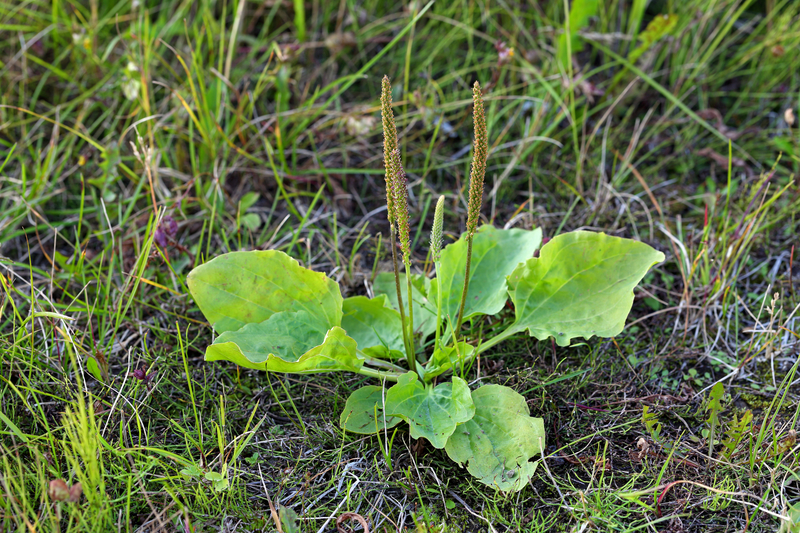The term “weed” has such a negative connotation for anyone who tries to keep a tidy yard. You find yourself rolling your eyes when you see new ones popping up. Instead, turn the good into the bad by starting with plantain. After you read about the effects it can have your health, you’ll probably be glad to see plantain on you property!
This powerful plant is often dismissed as a common weed and people don’t pay too much attention to it. Only few people know that It is nutritionally similar to dandelion: full of iron, vitamin C, vitamin K and B vitamins.
How to identify plantain
Broadleaf Plantains have three or five parallel veins that diverge in the wider part of the leaf. The leafless stems may grow in multiples from the base, standing tall and erect. The stem cones or spikes in a head of tiny flowers and can be a short cone or a long spike, with numerous tiny wind-pollinated flowers.
When to harvest plantain and where to find it
Look in your backyard as chances are you already have some plants growing undisturbed there. It likes growing in compact or disturbed soil on lawns, pastures, and fields. However, I’ve seen it growing out of the cracks of sidewalks and roads. Make sure to get it from an area that has not been sprayed with any chemicals or pesticides.
Medicinal uses of plantain
Plantain has been used by the first pioneers due to its natural antibacterial and anti-inflammatory properties. A tea made from the leaf can be sprayed on mosquito bites to ease the itch.
Externally, Plantain has been used for insect and snake bites, and as a remedy for rashes and cuts.
The seeds of Plantain may be difficult to harvest, but they worth the trouble as they can reduce blood cholesterol levels and are also widely used as a natural laxative.
Plantain Poultice
Plantain poultices have been used for centuries to promote the healing of bites, stings, sores and wounds. You can make a simple poultice by crushing fresh leaves then applying it to the infected area. Replace with fresh crushed leaves every day, until the wound heals.
The plant can also be used as a cough syrup and the recipe below was often used by my grandmother to treat coughs, sore throat, diarrhea or fatigue.
Ingredients:
- 3 cups fresh Plantain leaves, cleaned
- 1 cup honey (preferably raw and organic)
Method:
- Process the leaves in a food processor.
- Strain the juice into a saucepan through a cheesecloth.
- Add the honey to the juice.
- Simmer for about 10 minutes on low heat.
- Stir to mix.
- Allow to cool.
- Store in a clean glass bottle in a cool dark place.
- Take 1 teaspoonful, 3 times a day.
Plantain Infused Oil / Salve
Infused Plantain oils or salves are good for helping to heal skin conditions.
Method:
- Lightly bruise or crush clean, fresh Plantain leaves.
- Fill a clean glass jar with the bruised leaves.
- Use half the amount if using dried leaves.
- Cover the leaves with olive oil or your choice of oil.
- Cover and let sit in the sun for two weeks.
- The oil should turn deep green in color.
- Strain the leaves out.
- The oil is ready for use.
Method to Make a Salve:
- Add 1 oz of beeswax pastilles to 7 oz of plantain infused oil.
- Put the ingredients in a heatproof container.
- Set the container gently in a pan of warm water, making sure that there is not enough water to flow into your inner container.
- Gently increase the heat to medium-low until the wax melts.
- Stir the mixture.
- Remove it from the heat and pour it into a salve jar.
- Once cooled, the salve is ready for use.
Have you used plantain in any of these ways? What other recipes can harness the power of plantain?
Article Source: Prepper's Will

I’ve got this all over 😀
This plant does wonder’s !
Whst does it look like?
You can make flour out of the seeds to.
Jana Spalding
Jacky Honley Ammerman
our neighbor used to make it for psoriasis and sell it to other neighbors who said it worked. hse had a steady stream of customers so it could be useful. my son had excema and was allergic so we discontinued use as he said it itched like heck so its a try and see thing.
WORKS GREAT
Becky Scholz Johnson
Ragwort
Plantain??
Plantain
That is not ragwort. Here is a link to clarify for you.
Plantain
Thanks….i took a guess.
broadleaf Plantain.
we here in the foot heels of the blueridge mountain call it planten some folks cook it and enjoy .
Who told you to put on the balm? I didn’t tell you to put on the balm!
Its called Plantain..
Screw off with the click bait
Known that since I was a small child, don’t know it all but can salves
My sister in law made me some and it works great on any bites
Bob Brown
Doug Brown – Pat Brown